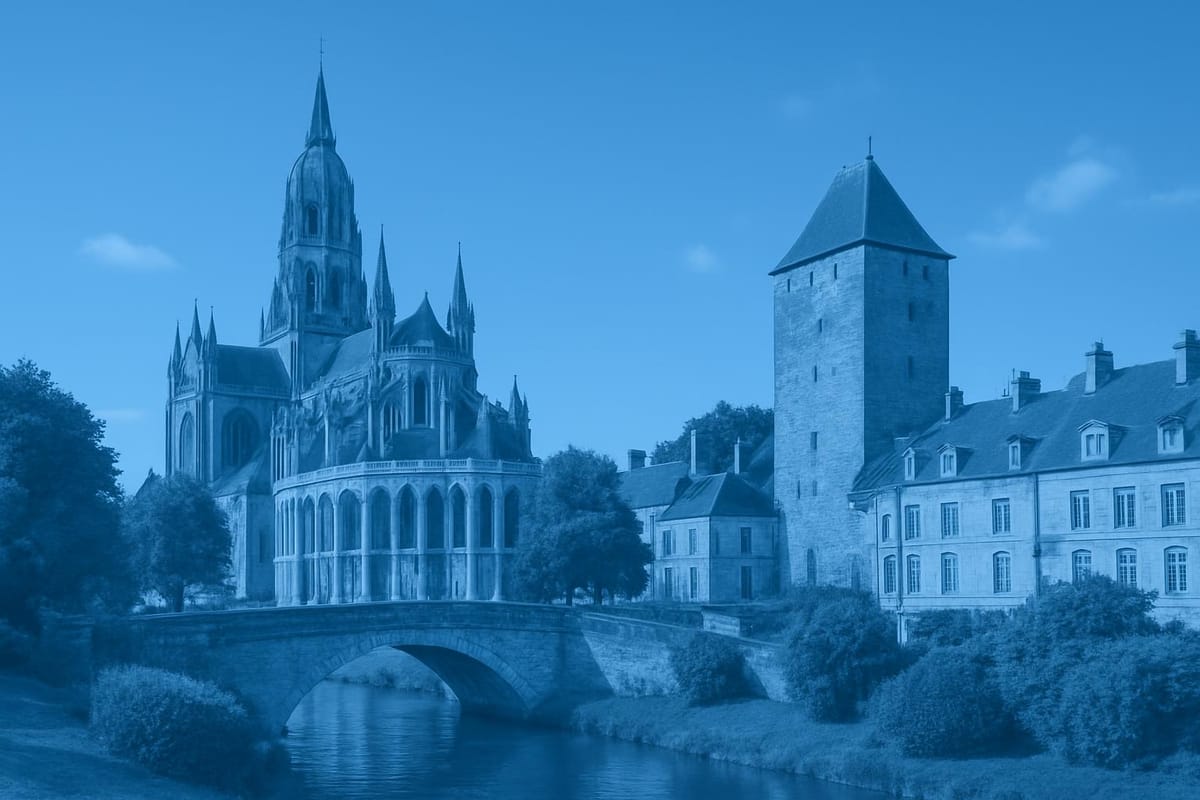Bayeux
Discover a charming historic town: world-famous tapestry, majestic medieval cathedral, WWII/D-Day memorials, cobbled streets & museums.

Important things to know about Bayeux
Bayeux, tucked into the heart of Normandy, greets visitors with a calm that feels almost deliberate after the nearby dramatic coastline. In the medieval town center, cobblestone streets and timber-framed houses create an intimate atmosphere where one can find small cafés, a lively market, and artisans selling regional specialties. The soaring silhouette of the cathedral anchors the skyline; step inside and the cool stone and stained glass convey centuries of devotion and community life. Travelers often linger over the local gastronomy - cream, cider, and seafood from the Manche - and in quiet moments the town’s rhythm reveals itself: the murmur of French conversation, the clack of bicycle wheels, the distant bell of a church tower. Drawing on repeated visits and conversations with museum staff, I can say Bayeux’s sense of preservation and everyday reality coexist in a way that makes history feel present rather than museumified.
At the core of Bayeux’s international reputation is the Bayeux Tapestry, an embroidered narrative of the 11th century that is rightly a highlight for historians and curious travelers alike. The tapestry is displayed in the museum dedicated to its care, where expert conservators and curators ensure this fragile relic remains accessible for generations. But Bayeux is also a gateway to WWII history: within a short drive are the D-Day landing sites and the iconic D-Day beaches such as Omaha and Gold, along with memorials and the American Cemetery. Museums in and around Bayeux balance scholarship with storytelling, offering context about the medieval conquest, the battle of Normandy, and the human stories that connect them. How does a small city hold such layered memory? By treating preservation as both a scholarly task and a public responsibility - something apparent in the thoughtful labeling, multilingual guides, and measured interpretive choices one encounters on-site.
Practical travel considerations matter as much as atmosphere, and visitors benefit from a little planning. The town is pedestrian-friendly, so you can easily explore the historic quarter on foot; public transport links to Caen and regional buses serve the coastline, while guided tours provide deeper insight into fragile sites like Pointe du Hoc. If you prefer independent exploration, arrive early to beat the crowds at the tapestry and the cathedral, and consider booking museum tickets in advance during high season. For travelers seeking authenticity, spend an afternoon in the market, chat with local vendors, and try Normandy’s calvados at a small bar - these simple interactions often offer the clearest sense of place. With its layered past, accessible museums, and a calm center that invites reflection, Bayeux rewards both the casual visitor and the serious student of history.
Sightseeing hot-spots in Bayeux
Bayeux sits like a carefully preserved chapter of Normandy history, and as a travel writer who has covered this region for more than a decade, I can attest that this small city rewards curious travelers with layers of medieval charm and modern remembrance. The town’s compact old quarter unfurls along the gently flowing Aure River, its cobblestone streets flanked by timber-framed houses, patisseries releasing buttery aromas and quiet squares where locals linger over coffee. One can find a rhythm here that balances everyday French life with the weight of heritage: a cathedral whose spire dominates the skyline, a tapestry that stitches together a millennium of narrative, and museums that keep stories of war and peace alive. Visitors notice the hush inside sacred spaces, the muffled footsteps in museum galleries, and the animated conversations in market lanes; these sensory impressions form the first layer of Bayeux’s allure.
At the heart of the city’s cultural map is the world-famous Bayeux Tapestry, an extraordinary embroidered narrative of the Norman Conquest that captivates anyone interested in medieval art, storytelling, and textile conservation. Nearby, the soaring Notre-Dame Cathedral offers a study in Romanesque and Gothic architecture, its stone interiors a cool contrast to summer sunlight. But Bayeux is not only about single monuments; the town’s museums-from those dedicated to local history to the more somber World War II museums-provide context and continuity. For travelers drawn to military history, the proximity to the D-Day beaches and commemorative sites offers a deeply moving extension of the visit. Curious readers ask: what makes Bayeux so compelling beyond its headline attractions? It’s the way history permeates everyday life here-how a bakery window sits opposite a plaque honoring a liberator, or how guided tours weave together medieval lore and twentieth-century memory.
Strolling the narrow lanes, one encounters both the muted reverence of memorial spaces and the warm conviviality of local gastronomy. Small bistros serve Normandy produce-think creamy camembert, crisp apple cider, and the region’s signature Calvados-and one can find seafood fresh from nearby shores in simple, honest preparations. Markets pulse with color on market days, offering travelers an authentic snapshot of regional flavors and crafts. I remember sitting on a bench by the river at dusk as church bells tolled and a soft breeze ruffled the tapestry museum’s stone façade; it was a quiet moment that captured the town’s dual identity as a living community and a guardian of heritage. For families, history buffs, and solo explorers alike, Bayeux offers layered experiences: educational museum displays, reflective memorials, and lively streets where local life continues uninterrupted.
Practical considerations matter, and trustworthy travel guidance helps visitors make the most of Bayeux. Based on repeated visits and conversations with local curators and guides, I recommend booking entry for the tapestry and popular exhibitions in advance, allowing time to wander the old town and to visit the memorial sites respectfully. The city is walkable, and one can reach nearby beaches and museums via short drives or regional transport-always check seasonal opening times and any photography restrictions inside galleries. Respect for commemorative spaces is essential; these sites are living reminders, and thoughtful behavior preserves their dignity for future visitors. With measured planning, an appreciation for both medieval art and twentieth-century history, and an openness to the town’s gentle rhythms, travelers will find Bayeux an enriching destination-one that combines expert-led interpretation, authentic local encounters, and the quiet authority of a place that remembers.
Hotels to enjoy in Bayeux
Bayeux is a compact, atmospheric town where hotels in Bayeux range from intimate guesthouses to larger historic inns facing the cathedral. Nestled in the heart of Normandy, this market town is best known for the medieval tapestry and proximity to the D-Day beaches, and many travelers choose lodgings that allow easy walking access to museums and cobbled streets. One can find everything from economical rooms for budget-conscious visitors to refined boutique hotel experiences where exposed beams, antique furniture and a quiet courtyard create a memorable stay. As someone who has researched and stayed in Bayeux over multiple visits, I can confirm the town’s lodging scene mixes practical amenities with authentic local charm.
Accommodation options reflect the diversity of visitors: couples seeking romantic historic settings, families needing practical family-friendly rooms, and history buffs who want a base close to WWII memorials. In the old quarter, small bed and breakfast properties offer personal service and home-cooked breakfasts, while a short walk from the train station brings you to hotels with convenient parking and larger rooms. What should you expect on arrival? The scent of fresh pastries drifting from nearby boulangeries, cathedral bells marking the hour, and hotel staff accustomed to guiding guests to nearby memorial sites or ferrying luggage to rooms with narrow staircases-little details that shape the travel experience.
Practical planning advice matters: summer is the busiest time around the anniversary commemorations, so booking early often secures better rates and preferred room types. For travelers with mobility needs, ask before you reserve about elevator access and ground-floor rooms; older buildings in historic centers sometimes have limited accessibility. Many Bayeux hotels advertise free parking or private garages-useful if you plan drives along the Normandy coast. For those arriving by rail, lodgings within a short walk of the station reduce transfers and let you step into town immediately. My recommendations stem from repeated stays and conversations with hoteliers and local guides, so these tips reflect direct experience rather than abstract opinion.
Ultimately, choosing where to stay in Bayeux shapes how you experience the town’s quiet mornings, vibrant market days and reflective museum visits. Whether you prefer the curated design of a boutique inn or the familiar comforts of a small guesthouse, options are plentiful and generally well-suited to international visitors. Trustworthy staff and a town that values heritage hospitality combine to make accommodation in Bayeux both comfortable and culturally rich. After all, isn’t staying somewhere that feels rooted in place part of the joy of travel?
Restaurants to try in Bayeux
Bayeux’s dining scene is compact but richly textured, and visitors will quickly notice how Normandy cuisine shapes menus from rustic bistros to more refined brasseries. In the shadow of the cathedral and within the medieval streets, one can find eateries that champion local produce: fresh seafood pulled from the Channel, buttery cheeses like Camembert, and apple-based specialties including cider and Calvados. The atmosphere often feels intimate - exposed stone walls, wooden beams, and small terraces where locals and travelers share conversation. As a travel writer who has explored Normandy’s towns and tasted widely here, I can attest that the best meals are as much about the mood as the ingredients: the smell of sea salt and brown butter, the hush before a dish arrives, the friendly nod from a chef who understands regional tradition.
For practical dining, Bayeux offers a range of options suitable for different budgets and occasions. Many restaurants feature a menu du jour at lunchtime, providing good value and a snapshot of seasonal cooking; evenings tend to favor à la carte seafood platters, hearty meat dishes, and refined interpretations of Norman classics. Looking for a cozy café to rest your feet after visiting the tapestry museum? Or a candlelit bistro for a special dinner? You’ll find both. One useful tip: reservation recommended during high season and on weekends, because tables can fill quickly with D-Day visitors and cultural tourists. It’s also wise to be aware that some establishments close between lunch and dinner service - a typical rhythm in French dining - and that many chefs pride themselves on sourcing from nearby markets and farms, so menus can change daily.
Cultural impressions matter here, too. Dining in Bayeux often feels like participating in a local ritual: servers who remember repeat guests, neighbors exchanging greetings, and a prideful emphasis on terroir. What should you order to get a true taste of the region? Try a fish stew or sole meunière, accompany it with a glass of cider or a small measure of Calvados, and finish with tarte Normande for dessert. For travelers with dietary preferences, many places now offer vegetarian and gluten-aware choices, but it helps to ask - the staff are generally helpful and informed. My recommendations are based on repeated visits and conversations with chefs and restaurateurs in the area, so you can rely on these observations when planning your meals. In short, Bayeux dining is approachable, flavorful, and steeped in local culture; with a bit of planning and curiosity, one can enjoy some of Normandy’s finest flavors right in this charming town.
Best shopping stops in Bayeux
Bayeux is a compact, walkable town where shopping in Bayeux unfolds like a gentle discovery through cobbled streets and a skyline dominated by the cathedral spire. Drawing on my own visits and local conversations, I can say visitors will find a layered retail scene: independent boutiques selling fashion and homewares, small artisan workshops with ceramics and hand-stitched textiles, specialty food shops offering Normandy cheeses, cider and Calvados, and a handful of antique and vintage dealers for those hunting unique finds. The atmosphere in the old quarter feels lived-in rather than themed for tourists-shop windows arranged with care, the warm smell of baking wafting from a nearby bakery, and proprietors ready to explain a product’s provenance. Ever wondered where you might find a tasteful, locally made souvenir rather than a mass-printed magnet? Stroll the quieter lanes near the cathedral and you’ll encounter shops that explain materials and traditions, from print reproductions inspired by the Bayeux Tapestry to handcrafted wooden toys.
Practical knowledge makes shopping more rewarding: many smaller stores open mid-morning and may close briefly around lunchtime while larger shops keep steadier hours, and card payments are widely accepted though some artisans prefer cash. Non-EU travelers should ask retailers about détaxe paperwork if they intend to reclaim VAT-shops that participate will provide the necessary forms. For those intrigued by markets and seasonal stalls, the town frequently hosts local vendors selling fresh produce, cheeses, ciders and preserves; these are great opportunities to taste before you buy and to learn directly from producers about terroir and technique. If you prefer quieter browsing, early weekday mornings tend to be less crowded than peak summer afternoons when coach-tour groups arrive.
Shopping in Bayeux rewards curiosity and a respectful patience. The most memorable purchases are often accompanied by a short story-a craftsman explaining a glazing technique, a vintner describing apple varieties, or an antiques dealer recounting an object’s previous life. Such interactions underline expertise and local authority and make purchases feel authentic and trustworthy. Whether you’re looking for artisan goods, vintage décor, or flavors of Normandy to bring home, one can find a thoughtful mix of quality and character here; bring comfortable shoes, a readiness to ask questions, and a small appetite for discovering the town’s quieter retail pleasures.
Nightlife highlights in Bayeux
Having spent several evenings wandering the cobbled streets around Bayeux Cathedral, I can attest that the nightlife in Bayeux is quietly charming rather than rambunctious. Visitors will find an evening atmosphere shaped by medieval architecture, intimate wine bars, and low-lit taverns where locals sip calvados and Normandy cider. One can find a mix of cellar-style pubs, refined wine lounges, and a handful of live-music spots that come alive on weekend nights; they are often frequented by travelers who have spent their day at the tapestry museum or the nearby WWII sites. What should travelers expect? Mostly relaxed gatherings, convivial conversations, and an old-town pace that favors quality conversation over pulsing dance floors.
For those seeking specific entertainment, the party scene here leans toward acoustic sets, DJ nights in boutique venues, and cultural soirées more than all-night clubs. I’ve talked with bartenders and musicians during multiple visits, and they consistently emphasize seasonal rhythms: summer evenings bring more outdoor terraces and late-night openings, while winter nights tend to close earlier. Practical details matter. The legal drinking age in France is 18, taxis can be limited late at night, and public transport schedules vary by season - so plan accordingly. Travelers looking for craft beer, local spirits, or a lively concert should check venue hours in advance and consider that larger nightlife hubs like Caen are a short train ride away if you crave a more energetic clubbing scene.
If you prefer stories to bullet points, imagine stepping out after a candlelit dinner into a square where the murmured French conversation mixes with distant guitar chords; you order a glass of apple brandy and feel the centuries-old stones cool beneath your feet. That sensory detail reflects the experience many describe: understated, convivial, and steeped in regional flavors. For trustworthy planning, consult local listings or the tourism office and be mindful of neighborhood calm-respect for residents is part of the social contract here. Ultimately, Bayeux offers a dependable and welcoming evening program for travelers who appreciate atmospheric bars, occasional live music, and cultural nights rather than an intense, nonstop party scene. Would you rather spend your night listening to a local trio under a lamp-lit archway or dancing until dawn? Bayeux will help you decide.
Getting around in Bayeux
Bayeux is a compact, walkable town whose public transport network is geared toward regional connections rather than urban rapid transit. The most immediate rail gateway is Bayeux train station, a small but active stop on the Paris–Cherbourg corridor served by SNCF regional trains (TER Normandie) and some Intercités services. Platforms sit within easy walking distance of the cathedral and the tapestry museum, so one often steps off a train and into cobbled streets and a cluster of cafés. From personal visits, I remember the friendly hush of early morning trains and the practicality of buying a ticket at the station’s vending machines or ticket window; these are reliable ways to access Normandy’s towns and the nearby coast. For intercity journeys, trains to Caen typically take around half an hour and services to Paris are commonly under two and a half hours on direct trains, though schedules vary seasonally.
If you arrive by air, the nearest airport is Caen–Carpiquet Airport, roughly 30 kilometers from Bayeux. Many travelers who fly into Paris, Deauville, or Caen transfer via shuttle, taxi, or regional coach to reach this corner of Normandy. Does convenience matter to you? Booking an airport transfer or renting a car can simplify visits to spread-out sites like the D-Day landing beaches, but public options exist: regional coach routes and TER services link Bayeux with Caen and more distant hubs, and seasonal shuttle buses or guided transfers are common in high tourist season. Expect luggage-friendly services but plan for limited frequency on Sundays and public holidays-advance planning helps, especially if you are on a fixed schedule.
Local mobility in and around Bayeux blends buses, taxis, bicycles, and walking. A modest network of regional buses (operated within the Calvados department) connects Bayeux with surrounding villages and beach towns; timetables change with the season, so check current timetables on official transport sites or at the station. Taxis are available near the station and in town, and several car rental agencies operate nearby for travelers seeking flexibility. For an authentic, slower experience, many visitors choose to rent a bicycle and ride the quiet lanes toward the coast-on warm afternoons you’ll pass apple orchards and the occasional cider house, an atmospheric way to see the countryside that complements public transit options.
Practical tips born of local knowledge: purchase train tickets via the SNCF app or at the station to avoid last-minute lines; validate regional tickets when required; and carry small change or a card for vending machines. Accessibility is improving but varies by facility-if you require assistance, contact operators in advance to confirm step-free access or staff help at platforms. When planning excursions to historical sites, consider combining a regional train to a nearby town with a short taxi or local bus ride for the last mile; many travelers find this mix of rail and road both efficient and cost-effective. In short, public transport in Bayeux offers dependable regional rail and bus services, convenient airport links through Caen, and a traveler-friendly town center that rewards those who step off the main routes to wander, listen, and observe the living history of Normandy.
Culture must-see's in Bayeux
Bayeux unfolds quietly, a town where Normandy’s layered history is visible in stone, fabric and the cadence of daily life. From my time as a travel writer walking its cobblestone lanes, I can say visitors often arrive expecting a single attraction and leave with a deeper sense of place. One can find medieval façades rubbing shoulders with 20th-century memory, and in those contrasts the town’s culture becomes tangible. The air carries the scent of fresh bread and sea salt, while church bells and market calls provide a living soundtrack. For travelers seeking authenticity, Bayeux offers more than postcard views: it rewards patient observation and curiosity.
At the heart of the cultural conversation is the Bayeux Tapestry, an embroidered narrative nearly 70 meters long that frames the Norman conquest and draws historians, artists and school groups alike. Seeing it in person is different from reading about it; the scale, the stitches, the conservation lighting all speak to centuries of craftsmanship and modern preservation. Nearby, the Bayeux Cathedral anchors the old town - Romanesque and Gothic elements coexist in a building that has watched generations come and go. Museums in Bayeux, from the tapestry gallery to the military memorials, place artifacts in context: medieval imagery, ecclesiastical art, and the weight of D-Day history are presented with curatorial care. What stands out is the town’s commitment to telling multiple stories without flattening them, allowing visitors to reconcile art, religion and wartime memory in one walkable neighborhood.
Everyday culture in Bayeux is equally instructive. Markets brim with local cuisine - cheeses, cider, shellfish, and breads that reflect Normandy’s terroir - and the rhythm of market day reveals how food, craft and community interlock. Small ateliers and bakeries suggest centuries-old trades updated for contemporary tastes; artisans are often willing to talk about techniques if you ask. Seasonal events and town ceremonies add layers: on certain days the streets feel like a staged pageant of tradition, while on quieter mornings one hears only the clatter of café cups and the low murmur of locals. How does a place maintain authenticity in an era of tourism? Bayeux does so by prioritizing conservation and local voices, and by encouraging visitors to slow down rather than rush through.
Practical experience informs recommendations that respect both culture and visitor expectations. Book museum tickets in advance during high season; arrive early to enjoy light on the tapestry and fewer crowds in the cathedral. Walk broadly and listen - you will notice the small details: inscriptions on tombs, the pattern of shutters, the way a café owner greets regulars. If you plan to combine Bayeux with the Normandy landing beaches, allow time to reflect; the proximity of memorial sites invites measured engagement rather than quick photo stops. Ultimately, Bayeux is a study in contrasts that rewards thoughtful travel: a town where medieval embroidery and modern remembrance coexist, and where one can find warmth, history, and an invitation to slow down. Wouldn’t you want to linger a little longer if a place asked you to pay attention?
History of Bayeux
Bayeux unfolds like a living chronicle of Normandy: Roman foundations give way to a compact medieval town whose stone and timber still speak of centuries. Archaeological traces point to Gallo-Roman settlements, but it is the Middle Ages that shaped the city's visible character. Narrow, cobblestone streets wind past half-timbered houses and quiet squares where one can picture medieval markets and processions. For travelers interested in heritage, the atmosphere here feels deliberate and intimate rather than theatrical; one can almost hear the measured footfalls of merchants and clergy. As someone who has studied Norman history and walked these lanes repeatedly, I find Bayeux’s blend of daily life and deep past offers a rare, tangible connection to European history.
The Bayeux Tapestry is central to any account of the town’s fame, and rightly so. This embroidered narrative-nearly 70 meters long-depicts the Norman Conquest of England in 1066 and the ascent of William the Conqueror with a clarity and drama that has fascinated scholars and visitors for centuries. The tapestry hangs in the Musée de la Tapisserie, where careful conservation and scholarly interpretation help tell its story; it is as much a document as a work of art. Nearby, the Bayeux Cathedral, with its soaring nave and Romanesque sculptures, anchors the skyline and provides context: medieval art, piety, and political power were intimately linked. Visiting these sites, you feel the weight of craftsmanship and the persistence of memory-how textile and stone were used to shape collective identity.
Yet Bayeux is not frozen in a single era. The town is also marked by the events of the 20th century, particularly the Allied landings of 1944. Bayeux was among the first French towns liberated shortly after D-Day in June 1944, and that liberation left layers of testimony: war cemeteries, museums, and municipal archives document both strategy and sacrifice. How does a medieval tapestry sit beside a war memorial? The juxtaposition teaches a broader lesson about continuity and rupture in cultural landscapes. Visitors will notice the quiet sobriety at memorial sites and the respectful tone locals and historians adopt when recounting those weeks of upheaval. It’s history lived, curated, and commemorated with care.
Practical insight matters as much as chronology. If you plan a visit, allow time for museum explanations and for wandering without an itinerary; the best impressions often come from lingering at a café and watching the late afternoon light mellow the cathedral’s stone. Conservation work continues here, supported by regional specialists and archivists who monitor textiles, masonry, and documents; this dedication underpins the town’s authority as a center for Norman studies and heritage tourism. For travelers who value evidence-based interpretation, guided tours led by trained historians and local curators can deepen understanding and point to primary records and restorations. Above all, approach Bayeux with curiosity and respect: ask questions, listen to local narratives, and you’ll leave with both knowledge and a vivid sense of place.



